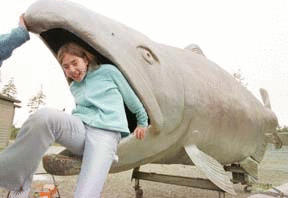Sakai Intermediate School students caught a big fish this week.
The 25-foot-long, one-ton fiberglass salmon “swimming” next to the school is part of a salmon-restoration project inspired by the school’s location.
“On the western edge of the Sakai campus runs a stream that partially shapes Sakai’s identity,” project coordinator and librarian Jan Johnson said. “Our close ties with this natural setting are clearly seen in the in the title of our newsletter, the ‘Coho Connection,’ in our mascot choice of the coho, and in the hallway art in the form of student-made fish that hang overhead outside the library.”
The project, Johnson says, will also help Sakai students understand what is involved in watershed management by labeling each of the school’s storm drains as emptying into the stream.
The project serves as a community-building exercise for Sakai students and teachers, Johnson says.
“We are still a new school,” Johnson said. “So we need to do things that bring the whole community together.”
The project, “Mainstreaming Sakai’s Stream,” is funded for three years with a $2,000 grant from Bainbridge Education Support Team, money Johnson applied for last fall.
The funds purchased the large tank located at the entrance to the school’s library and the complex cooling system where the school’s salmon were raised from 2,000 eggs purchased from the Grovers Creek Hatchery, a Suquamish tribal facility.
The Sakai stream was deemed viable for the project because the water is clear and moving.
Several wild salmon have been sighted there recently, Johnson says.
Every school day this week, classes took turns releasing salmon. Individual students scooped inch-long salmon fry from the tank, using paper cups.
Then they released the fish into the stream with words of advice teachers had asked them to prepare.
“They gave ‘their’ fish words of wisdom – how to avoid predators, for instance” Johnson said. “We also told the students Native American salmon legends.”
Beside releasing the fish, students viewed the 150 Northwest wild species painted on the hollow interior of the giant salmon.
Constructed in 1988 by the nonprofit group Wild Olympic Salmon, the fish-on-wheels travels throughout Washington.
Although Coho salmon is the species indigenous to the stream, Grovers Creek experts recommended chum salmon for the school project because chum salmon head directly for salt water rather than spending a year in the stream they hatch.
The salmon fry released behind Sakai will mature fully in four years.
“We hope that some will survive,” Johnson said. “We didn’t actually release very many. But if even one comes back to spawn, we will be happy.”



